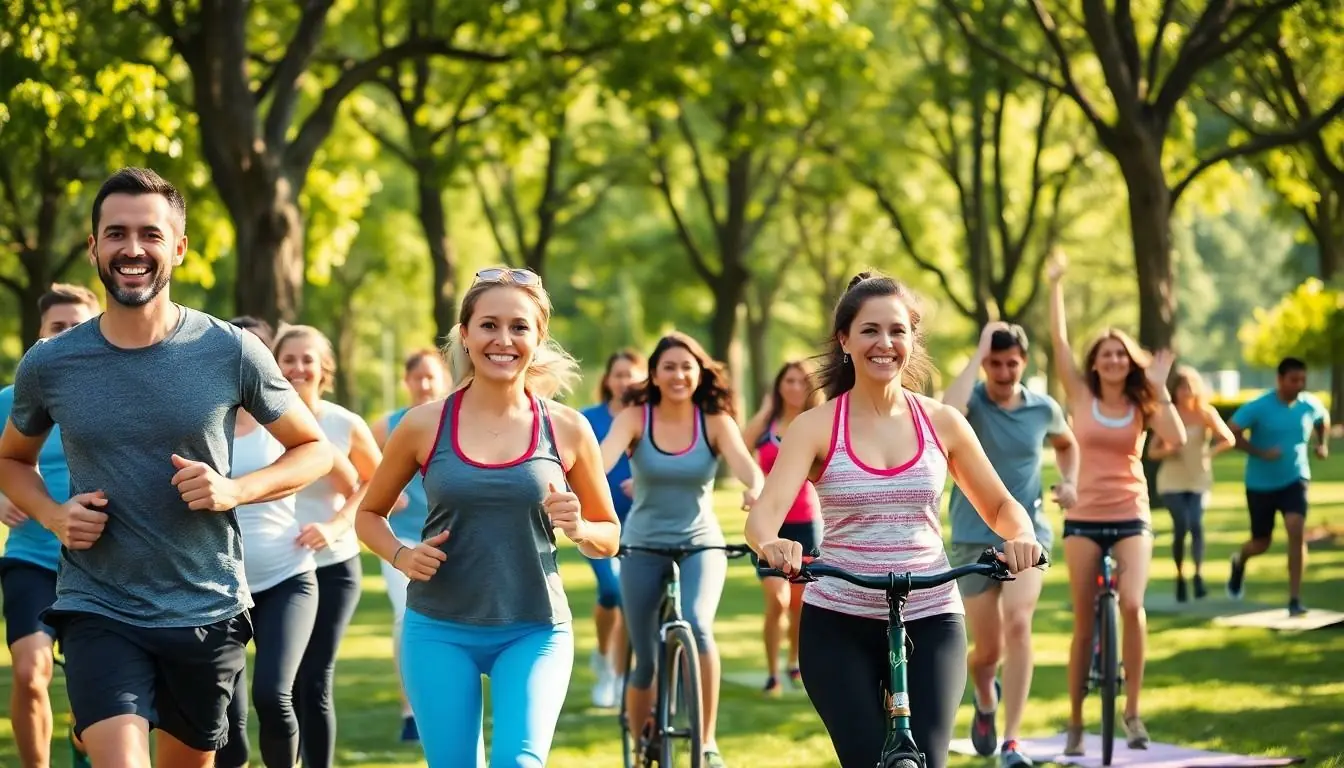In a world where couch surfing is an Olympic sport, it’s easy to forget that physical activities can actually be fun and beneficial. From dancing like nobody’s watching to channeling your inner ninja on a hiking trail, staying active doesn’t have to feel like a chore. But with so many options out there, it’s crucial to know which activities truly boost health and which ones might just be a clever ruse to get you to sweat it out in spandex.
Table of Contents
ToggleOverview of Physical Activities
Physical activities encompass a wide range of movements that contribute to overall health. Regular engagement in these activities leads to improved cardiovascular fitness, enhanced muscle strength, and increased flexibility. Importantly, activities such as brisk walking, cycling, and swimming stand out due to their accessibility and effectiveness.
Many people enjoy group classes that include aerobics, yoga, or kickboxing. These social environments foster motivation and accountability, making it easier to commit to a fitness routine. Outdoor activities, like hiking or jogging in nature, offer additional mental health benefits due to exposure to fresh air and scenic views.
Resistance training plays a crucial role in maintaining muscle mass and strength, especially for older adults. Incorporating weights two to three times a week can significantly enhance physical health. Dancing frequently ranks as a favorite among individuals seeking fun while burning calories. Not only does it improve coordination, but it also elevates mood.
Water-based exercises like aqua aerobics provide low-impact options for many people, including those recovering from injuries. Engaging in such activities can ease pressure on joints while promoting fitness. Mind-body exercises, which include Pilates and tai chi, focus on balance and core strength.
It’s essential to evaluate personal preferences and capacities when choosing suitable activities. People may find some exercises enjoyable while others might feel challenging. Understanding one’s own limits ensures safety and long-term commitment to a healthier lifestyle.
Health Benefits of Physical Activities

Engaging in physical activities yields numerous health benefits, impacting both physical and mental wellness. Regular participation enhances overall health and fitness.
Physical Health Benefits
Physical activities improve cardiovascular health by reducing the risk of heart disease and hypertension. They also help maintain weight, optimizing metabolic function. Strength training supports muscle mass and bone density, essential for aging individuals. Flexibility exercises enhance joint health, making everyday movements easier. Activities like swimming or cycling promote endurance, contributing to better overall fitness levels.
Mental Health Benefits
Physical activities significantly boost mental health, reducing symptoms of anxiety and depression. Exercise triggers the release of endorphins, natural mood elevators that enhance happiness. Social engagement during group activities fosters a sense of community, reducing feelings of isolation. Mind-body exercises, such as yoga, promote relaxation and mindfulness, improving emotional resilience. Regular activity contributes to improved cognitive functions, enhancing focus and memory.
Common Misconceptions About Physical Activities
Many believe that all forms of physical activity are equally beneficial. In reality, certain activities offer more health advantages than others. Some individuals think that strenuous workouts yield better results than moderate exercises. However, research shows that consistent moderate activities, like brisk walking, significantly enhance cardiovascular health and overall fitness levels.
Another misconception is that physical activities require gym membership. Accessible options such as hiking, cycling, or even walking at a local park contribute to health benefits without a gym’s constraints. It’s essential for everyone to identify what resonates with them to promote regular engagement.
Some people assume that age limits the ability to participate in physical activities. Yet, resistance training proves vital for older adults, helping maintain muscle mass and bone density. Their involvement in activities like dancing or tai chi can foster social interactions while enhancing physical wellness.
Additionally, many think that only high-intensity workouts can elevate mood and mental health. Lower-intensity exercises also play a crucial role in alleviating anxiety and depression, boosting endorphins effectively. Group settings in activities like yoga or aerobics promote social connections, yielding additional emotional support.
The notion that exercises must be lengthy to be effective is another common fallacy. Short bursts of activity throughout the day can accumulate significant health benefits. Individuals might not realize that even 10 minutes of movement contributes to better fitness and overall well-being.
Recognizing these misconceptions helps individuals make informed choices about their physical activities. Engaging in the right activities leads to improved health outcomes and promotes a sustainable lifestyle.
Activities That Are Not Beneficial
Certain activities can hinder health rather than promote it. Recognizing these options helps individuals focus on effective physical pursuits.
Sedentary Activities
Sedentary activities include prolonged sitting or lying down without engagement in movement. Common examples are watching television, playing video games, and excessive computer use. These activities contribute to weight gain, reduce cardiovascular health, and lead to muscle deterioration. Spending more than two hours daily on sedentary activities can increase the risk of chronic diseases. Individuals often overlook the importance of incorporating movement into their routine, thus missing opportunities for better health.
Wrong Exercise Practices
Certain exercise practices can impede health benefits rather than enhance them. Using improper techniques in strength training, for instance, can lead to injuries. Overtraining without adequate rest disrupts recovery, decreasing performance and increasing fatigue. Engaging in exercises that lack variety may result in monotony and reduced motivation. Moreover, distractions during workouts, like excessive phone usage, can diminish focus and effectiveness. Individuals benefit from prioritizing safe and well-rounded exercise routines, ensuring they promote rather than hinder health.
Choosing the right physical activities is essential for promoting health and well-being. Engaging in enjoyable and effective exercises can lead to numerous benefits, from improved cardiovascular fitness to enhanced mental health. By focusing on activities that genuinely contribute to overall wellness, individuals can create a sustainable and fulfilling fitness routine.
It’s crucial to recognize which activities may hinder health rather than help it. By avoiding sedentary behaviors and improper exercise techniques, individuals can ensure their efforts lead to positive outcomes. Making informed choices about physical activities empowers everyone to achieve their health goals and enjoy a more active lifestyle.
